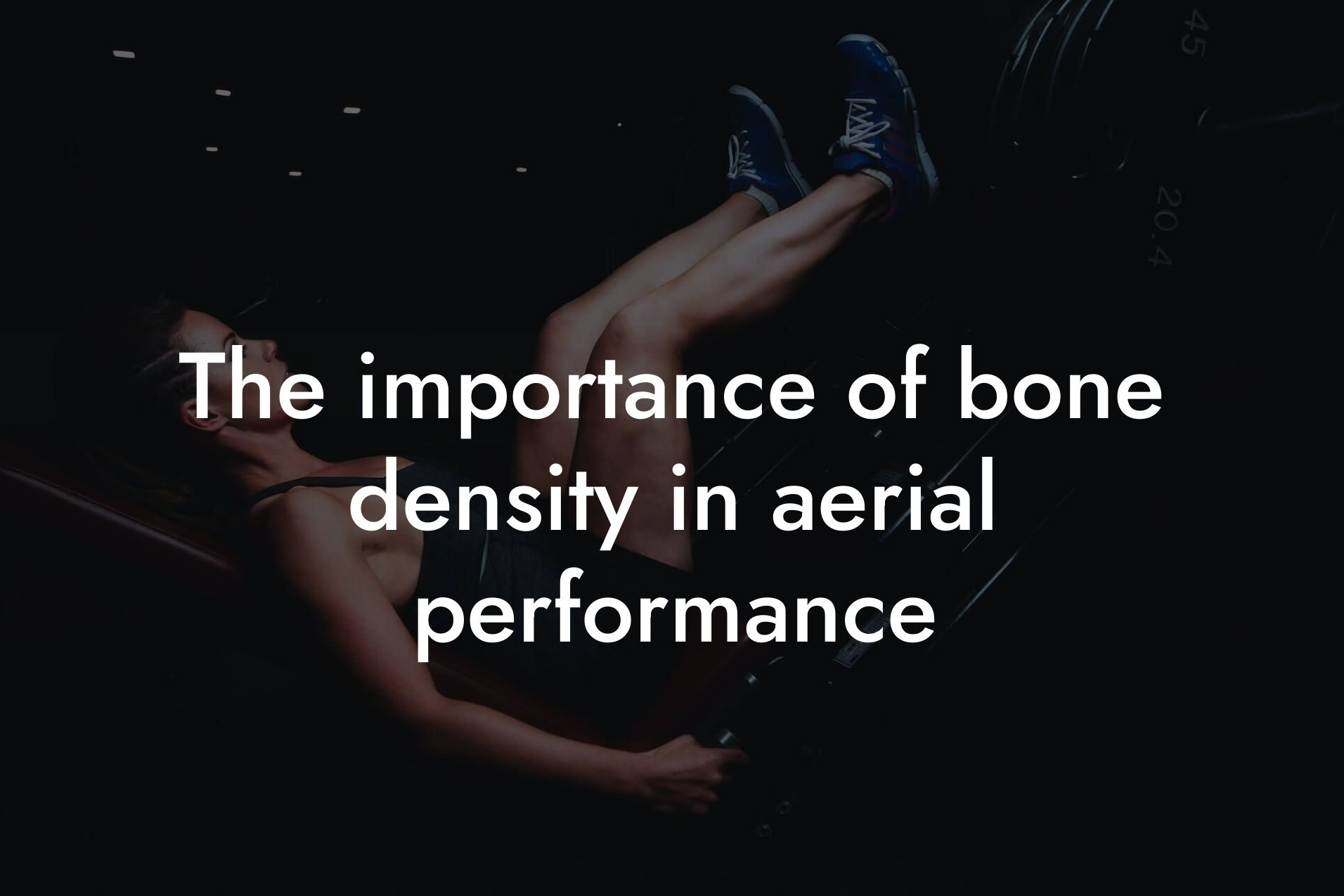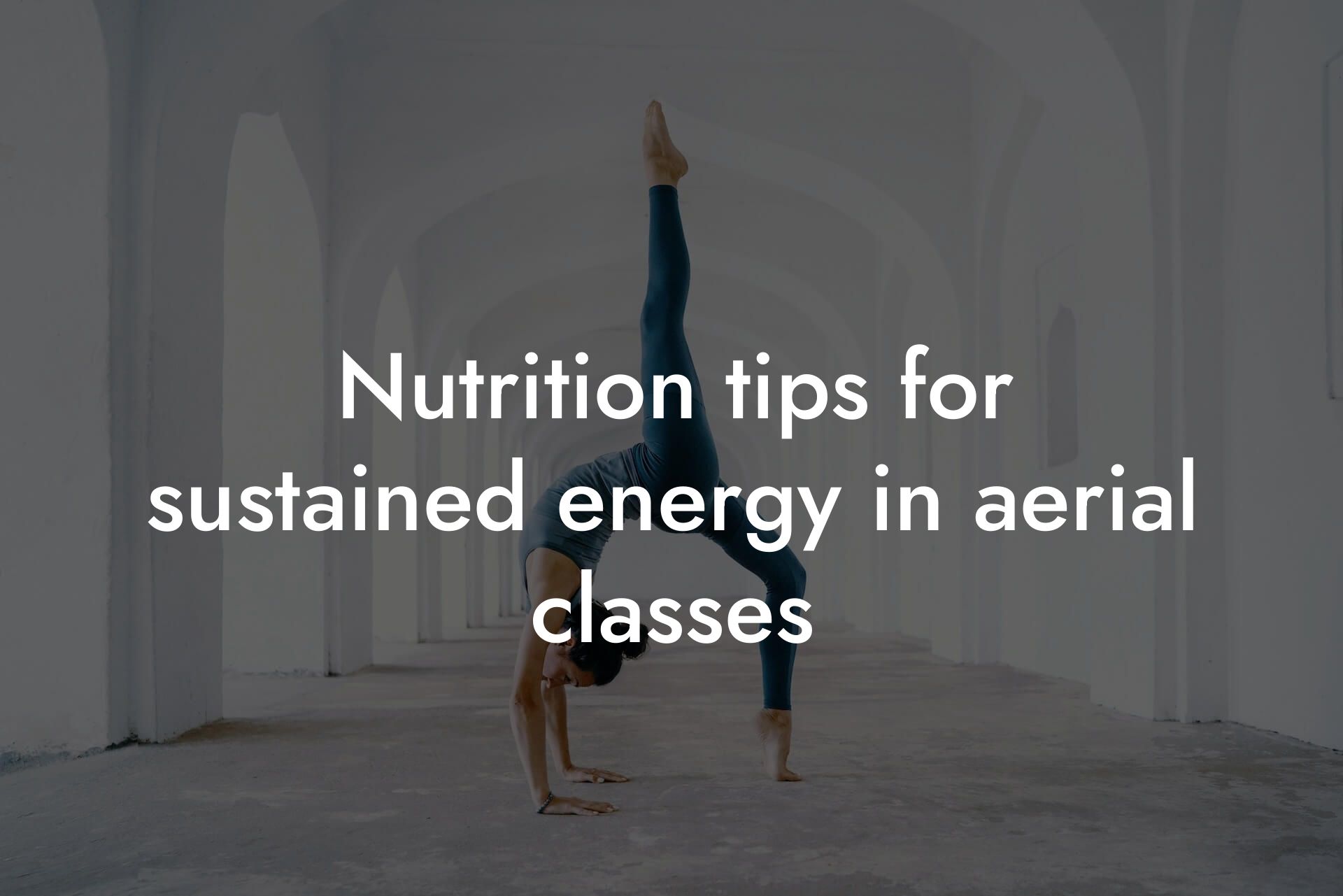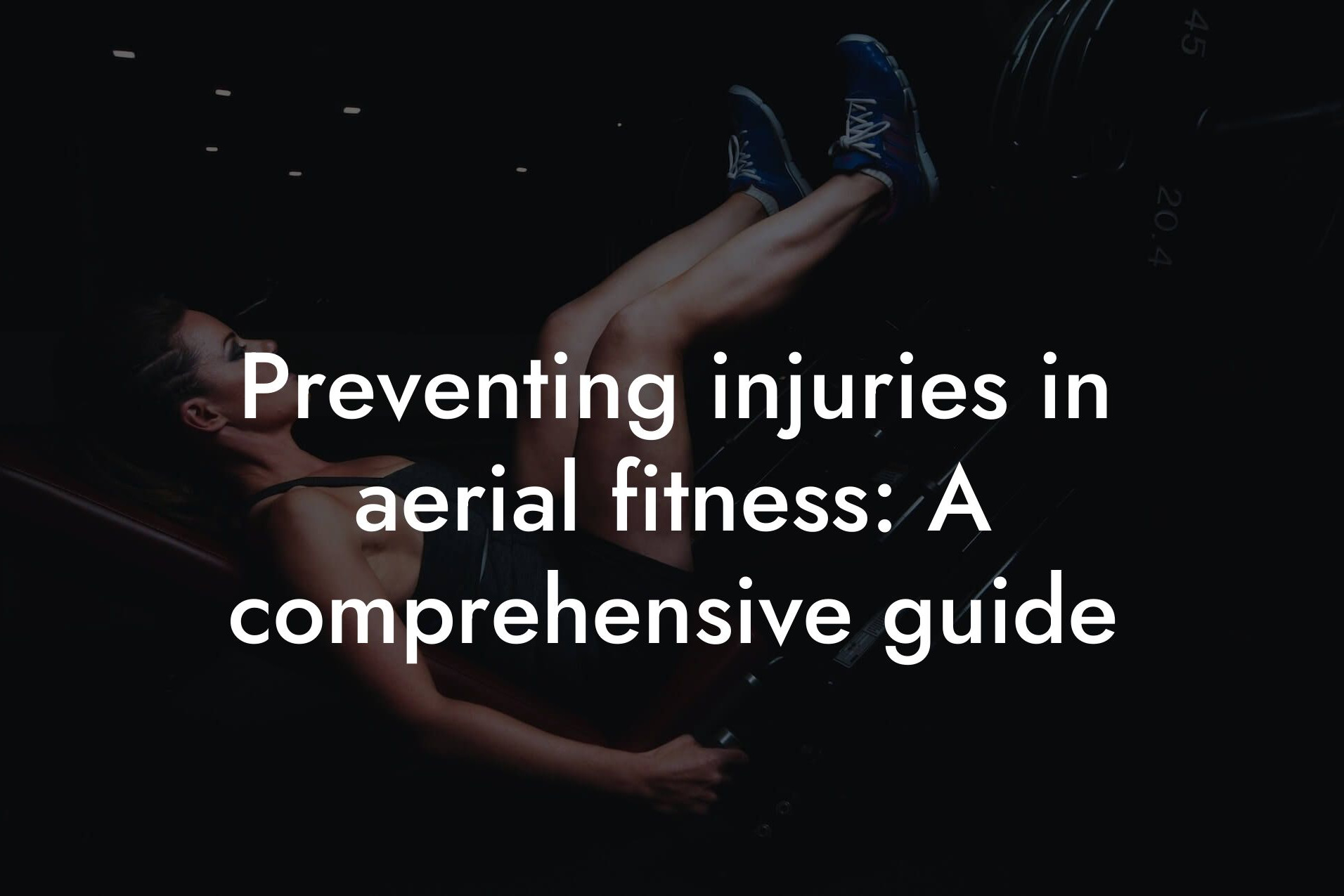As a high-earning professional, you understand the importance of maintaining a strong and healthy physique. Aerial fitness, which involves performing aerial acrobatics and poses while suspended in the air, requires a unique combination of strength, flexibility, and endurance. In this article, we'll provide you with expert strength training tips specific to aerial fitness, helping you to take your skills to new heights.
Table of Contents
Building a Strong Foundation
Before you can start flying high, you need to build a strong foundation. This means focusing on exercises that target your core, arms, legs, and glutes. These muscle groups are essential for maintaining control and stability while in the air. Incorporate exercises like squats, lunges, deadlifts, and bench press into your workout routine to build overall strength and stability.
Incorporating Aerial-Specific Exercises
While traditional strength training exercises are essential, you'll also need to incorporate aerial-specific exercises into your routine. These exercises will help you develop the strength and control needed to perform aerial poses and movements. Some examples of aerial-specific exercises include:
- Inverted rows: This exercise targets your back and arm muscles, helping you to maintain control while in an inverted position.
- Aerial leg lifts: This exercise targets your core and leg muscles, helping you to lift and control your legs while in the air.
- Hanging leg raises: This exercise targets your core and leg muscles, helping you to raise and lower your legs while hanging from the aerial equipment.
Flexibility and Mobility
Flexibility and mobility are crucial components of aerial fitness. You'll need to be able to move freely and comfortably in the air, which requires a good range of motion in your shoulders, hips, and spine. Incorporate stretching exercises into your routine, focusing on your hamstrings, quadriceps, and hip flexors. You can also incorporate mobility exercises like leg swings and arm circles to improve your range of motion.
Endurance and Cardiovascular Training
Aerial fitness can be physically demanding, requiring sustained periods of physical activity. To improve your endurance and cardiovascular health, incorporate cardio exercises into your routine. This can include activities like running, cycling, or swimming, as well as high-intensity interval training (HIIT). Aim to do at least 20-30 minutes of cardio exercise per session, 2-3 times per week.
Core Strength and Control
Core strength and control are essential for aerial fitness. Your core muscles, including your abs and obliques, help you to maintain control and stability while in the air. Incorporate exercises like planks, Russian twists, and leg raises into your routine to target your core muscles. You can also incorporate isometric exercises like wall sits and glute bridges to improve your overall core strength.
Injury Prevention and Safety
Injury prevention and safety are critical components of aerial fitness. Always warm up before training, and make sure to cool down afterwards to prevent muscle strain. Listen to your body and take regular breaks to avoid fatigue and injury. It's also essential to work with a qualified instructor or trainer who can provide guidance and support.
Progressive Overload and Periodization
To continue making progress in aerial fitness, you'll need to incorporate progressive overload and periodization into your training routine. Progressive overload involves gradually increasing the intensity of your workouts over time, while periodization involves varying your training routine to avoid plateaus. This can include changing your exercise routine, increasing the weight or resistance, or incorporating new skills and movements.
Monitoring Progress and Setting Goals
Monitoring your progress and setting goals is essential for achieving success in aerial fitness. Use a DEXA machine to track your body composition and bone density, and set specific, measurable goals for yourself. This can include improving your strength, increasing your endurance, or mastering new skills and movements. By setting goals and tracking your progress, you'll be motivated to continue pushing yourself to new heights.
By incorporating these strength training tips into your aerial fitness routine, you'll be able to take your skills to new heights and achieve the strong, healthy physique you desire. Remember to always prioritize injury prevention and safety, and to monitor your progress and set goals to stay motivated and focused. With dedication and hard work, you can unlock the full potential of aerial fitness and take your physical appearance to the next level.
Frequently Asked Questions
What is aerial fitness and how does it differ from traditional strength training?
Aerial fitness is a form of exercise that combines traditional strength training with aerial movements, using equipment such as aerial silks, hammocks, or swings to add an extra dimension to your workout. This type of training targets not only your physical strength but also your flexibility, coordination, and overall body awareness. In contrast to traditional strength training, aerial fitness requires more core engagement, spatial awareness, and trust in your body's ability to navigate unusual movements.
Do I need prior experience with aerial activities to start strength training for aerial fitness?
No, you don't need prior experience with aerial activities to start strength training for aerial fitness. However, having a basic understanding of aerial movements and safety protocols is recommended. Our strength training tips and exercises are designed to be adaptable to your fitness level, and we provide guidance on how to modify exercises to suit your needs.
What are the benefits of incorporating strength training into my aerial fitness routine?
Incorporating strength training into your aerial fitness routine can improve your overall performance, increase your endurance, and reduce your risk of injury. Strength training also helps build confidence and trust in your body's abilities, allowing you to push yourself to new heights (literally!). Additionally, strength training can improve your bone density, which is essential for aerial activities that involve suspension and weight-bearing exercises.
How often should I strength train for aerial fitness?
We recommend strength training at least 2-3 times a week, with a minimum of 30-45 minutes per session. However, this frequency and duration may vary depending on your individual goals, fitness level, and aerial activity schedule. It's essential to listen to your body and allow for rest days to avoid burnout and prevent injuries.
What are the most important muscle groups to focus on for aerial fitness?
The most important muscle groups to focus on for aerial fitness are your core, shoulders, back, and legs. These muscle groups provide the foundation for stability, control, and power in aerial movements. Additionally, strong glutes and hamstrings are essential for lifting and supporting your body weight in aerial poses.
Can I use traditional strength training exercises for aerial fitness, or do I need to modify them?
While traditional strength training exercises can be beneficial, they may not specifically target the muscle groups and movements required for aerial fitness. We recommend modifying exercises to incorporate aerial-specific movements, such as inverted rows, hanging leg raises, and aerial-inspired plyometrics. Our strength training tips and exercises are designed to help you adapt traditional exercises to aerial fitness.
How do I modify traditional strength training exercises for aerial fitness?
To modify traditional strength training exercises for aerial fitness, focus on incorporating movements that mimic aerial poses and transitions. For example, you can modify a traditional push-up by adding a hang or inverted element, or modify a squat by incorporating a swing or rotation. We provide guidance on how to modify exercises to suit your needs and goals.
What equipment do I need to get started with aerial fitness strength training?
To get started with aerial fitness strength training, you'll need access to aerial equipment such as silks, hammocks, or swings. You can find aerial studios or gyms that offer classes and equipment rentals, or invest in your own equipment for home use. Additionally, you may need resistance bands, dumbbells, or other traditional strength training equipment to supplement your aerial training.
Can I strength train for aerial fitness at home, or do I need to join a studio or gym?
You can strength train for aerial fitness at home, but we recommend joining a studio or gym that offers aerial classes and equipment rentals. Aerial studios and gyms provide a safe and controlled environment, expert instruction, and access to specialized equipment. However, if you prefer training at home, we provide guidance on how to create a safe and effective workout space.
How do I prevent injuries while strength training for aerial fitness?
To prevent injuries while strength training for aerial fitness, it's essential to warm up properly, listen to your body, and start with modifications that suit your fitness level. Additionally, focus on building strength and control gradually, and avoid pushing yourself too hard too quickly. We provide guidance on injury prevention and management, as well as tips for safe and effective training.
Can I strength train for aerial fitness if I have a pre-existing injury or condition?
Yes, you can strength train for aerial fitness with a pre-existing injury or condition, but it's essential to consult with a healthcare professional or certified trainer to develop a modified workout plan that suits your needs. We provide guidance on how to adapt exercises to accommodate common injuries and conditions, such as shoulder or back injuries.
How do I incorporate cardio into my aerial fitness strength training routine?
To incorporate cardio into your aerial fitness strength training routine, try adding high-intensity interval training (HIIT) exercises, plyometrics, or cardio-based aerial movements. You can also incorporate cardio exercises between strength training sets or as a warm-up/cool-down. We provide guidance on how to incorporate cardio effectively and safely.
Can I use aerial fitness strength training to improve my overall physique and body composition?
Yes, aerial fitness strength training can help improve your overall physique and body composition. Aerial fitness exercises target multiple muscle groups simultaneously, which can help increase your metabolism and burn fat. Additionally, aerial fitness can help improve your bone density, which is essential for overall health and wellness.
How does aerial fitness strength training compare to traditional weightlifting or bodybuilding?
Aerial fitness strength training is a unique and holistic approach to strength training that combines elements of traditional weightlifting, bodybuilding, and gymnastics. While traditional weightlifting and bodybuilding focus on building bulk and strength, aerial fitness strength training targets functional strength, flexibility, and body awareness. Our approach is designed to improve your overall fitness and athleticism, rather than just building muscle mass.
Can I use aerial fitness strength training to improve my mental health and confidence?
Yes, aerial fitness strength training can have a profound impact on your mental health and confidence. Aerial fitness exercises require trust, focus, and self-awareness, which can help build confidence and self-esteem. Additionally, the physical and mental challenges of aerial fitness can help reduce stress and anxiety, and improve overall mental well-being.
How does aerial fitness strength training benefit my bone density?
Aerial fitness strength training is an excellent way to improve your bone density, particularly in the upper body, shoulders, and spine. Aerial exercises involve weight-bearing and suspension movements that stimulate bone growth and density. This is especially important for individuals at risk of osteoporosis or osteopenia.
Can I incorporate aerial fitness strength training into my rehabilitation or physical therapy program?
Yes, aerial fitness strength training can be an excellent addition to your rehabilitation or physical therapy program. Aerial exercises can help improve range of motion, strength, and flexibility, while also promoting functional movement and body awareness. Consult with your healthcare professional or certified trainer to develop a modified workout plan that suits your needs.
How do I track my progress and measure my success in aerial fitness strength training?
To track your progress and measure your success in aerial fitness strength training, focus on metrics such as increased strength, improved flexibility, and enhanced body awareness. You can also track your progress through photos, videos, or measurements, and celebrate small victories along the way. We provide guidance on how to set and achieve your goals, and track your progress effectively.
Can I use aerial fitness strength training to improve my overall athleticism and sports performance?
Yes, aerial fitness strength training can help improve your overall athleticism and sports performance. Aerial exercises target functional strength, power, and agility, which can translate to improved performance in various sports and activities. Additionally, aerial fitness can help improve your coordination, balance, and body awareness, making you a more well-rounded athlete.
How does aerial fitness strength training compare to other forms of exercise, such as yoga or Pilates?
Aerial fitness strength training is a unique and holistic approach to exercise that combines elements of yoga, Pilates, and gymnastics. While yoga and Pilates focus on flexibility, balance, and core strength, aerial fitness adds an extra dimension of suspension and weight-bearing exercises. Our approach is designed to improve your overall fitness, athleticism, and body awareness.
Can I use aerial fitness strength training to improve my flexibility and range of motion?
Yes, aerial fitness strength training is an excellent way to improve your flexibility and range of motion. Aerial exercises involve dynamic movements and stretches that can help increase your flexibility, particularly in the shoulders, hips, and spine. We provide guidance on how to incorporate flexibility exercises into your aerial fitness routine.
How does aerial fitness strength training benefit my overall health and wellness?
Aerial fitness strength training is a holistic approach to exercise that benefits your overall health and wellness. Aerial exercises can help improve your cardiovascular health, increase your strength and flexibility, and enhance your body awareness and coordination. Additionally, aerial fitness can help reduce stress and anxiety, and improve your overall mental well-being.
Here are some related articles you might love...
- The importance of bone density in aerial performance
- Nutrition tips for sustained energy in aerial classes
- Preventing injuries in aerial fitness: A comprehensive guide
- Improving core strength for aerial arts
- How body composition affects performance in aerial fitness
- Maintaining muscle recovery with aerial training
- Reducing body fat for improved strength-to-weight ratio in aerial arts
- Using DEXA scans to monitor progress in aerial fitness
- Balancing strength and flexibility in aerial fitness
Zak Faulkner
Zak Faulkner is a leading authority in the realm of physical health and body composition analysis, with over 15 years of experience helping professionals optimise their fitness and well-being. As one the experts behind Tano Performance Group, Zak has dedicated his career to providing in-depth, science-backed insights that empower clients to elevate their physical performance and overall health.
With extensive knowledge of DEXA technology, Zak specializes in delivering comprehensive body assessments that offer precise data on body fat, muscle mass, bone density, and overall physique. His expertise enables individuals to make informed decisions and achieve their fitness goals with accuracy and confidence. Zak’s approach is rooted in a deep understanding of human physiology, combined with a passion for helping clients unlock their full potential through personalised strategies.
Over the years, Zak has earned a reputation for his commitment to excellence, precision, and client-focused service. His guidance is trusted by top professionals who demand the best when it comes to their health. Whether advising on fitness programs, nutritional strategies, or long-term wellness plans, Zak Faulkner’s insights are a valuable resource for anyone serious about taking their health and fitness to the next level.
At Tano Performance Group, Zak continues to lead our Content Team revolutionising how professionals approach their physical health, offering unparalleled expertise that drives real results.




